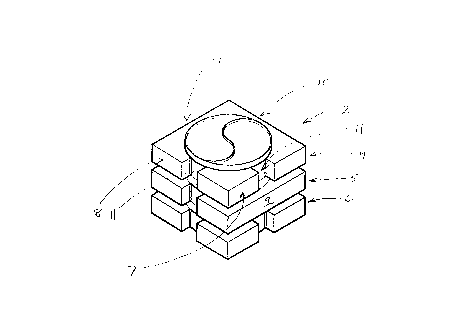Une partie des informations de ce site Web a été fournie par des sources externes. Le gouvernement du Canada n'assume aucune responsabilité concernant la précision, l'actualité ou la fiabilité des informations fournies par les sources externes. Les utilisateurs qui désirent employer cette information devraient consulter directement la source des informations. Le contenu fourni par les sources externes n'est pas assujetti aux exigences sur les langues officielles, la protection des renseignements personnels et l'accessibilité.
L'apparition de différences dans le texte et l'image des Revendications et de l'Abrégé dépend du moment auquel le document est publié. Les textes des Revendications et de l'Abrégé sont affichés :
| (12) Demande de brevet: | (11) CA 2211286 |
|---|---|
| (54) Titre français: | DISPOSITIF DE TRIGRAMME |
| (54) Titre anglais: | TRIGRAM DEVICE |
| Statut: | Réputée abandonnée et au-delà du délai pour le rétablissement - en attente de la réponse à l’avis de communication rejetée |
| (51) Classification internationale des brevets (CIB): |
|
|---|---|
| (72) Inventeurs : |
|
| (73) Titulaires : |
|
| (71) Demandeurs : |
|
| (74) Agent: | DENNISON ASSOCIATES |
| (74) Co-agent: | |
| (45) Délivré: | |
| (22) Date de dépôt: | 1997-07-24 |
| (41) Mise à la disponibilité du public: | 1999-01-24 |
| Licence disponible: | S.O. |
| Cédé au domaine public: | S.O. |
| (25) Langue des documents déposés: | Anglais |
| Traité de coopération en matière de brevets (PCT): | Non |
|---|
| (30) Données de priorité de la demande: | S.O. |
|---|
Un dispositif pour former des trigrammes et des hexagrammes a trois plaques tournantes montées de manière à pouvoir tourner autour d'un axe commun. Chaque plaque a quatre faces exposées, deux des faces représentant une ligne pleine d'un trigramme et les deux autres faces représentant une ligne interrompue d'un trigramme. Le dispositif permet que les plaques soient alignées de manière à former trois lignes superposées représentant un trigramme à 64 possibilités de combinaison. De préférence, le dispositif comporte un moyen de verrouillage pour faciliter l'alignement des plaques.
A device for forming trigrams and hexagrams was
three rotatable mounted for rotation about a common axis.
Each plate has four exposed faces, with two of the faces
representing a solid line of a trigram and the remaining
two faces representing a broken line of a trigram. The
device allows the plates to be aligned to form three
stacked lines representing a trigram of 64 possible
trigrams. Preferably the device includes a lock
arrangement for facilitating alignment of the plates.
Note : Les revendications sont présentées dans la langue officielle dans laquelle elles ont été soumises.
Note : Les descriptions sont présentées dans la langue officielle dans laquelle elles ont été soumises.

2024-08-01 : Dans le cadre de la transition vers les Brevets de nouvelle génération (BNG), la base de données sur les brevets canadiens (BDBC) contient désormais un Historique d'événement plus détaillé, qui reproduit le Journal des événements de notre nouvelle solution interne.
Veuillez noter que les événements débutant par « Inactive : » se réfèrent à des événements qui ne sont plus utilisés dans notre nouvelle solution interne.
Pour une meilleure compréhension de l'état de la demande ou brevet qui figure sur cette page, la rubrique Mise en garde , et les descriptions de Brevet , Historique d'événement , Taxes périodiques et Historique des paiements devraient être consultées.
| Description | Date |
|---|---|
| Inactive : CIB de MCD | 2006-03-12 |
| Demande non rétablie avant l'échéance | 2000-07-24 |
| Le délai pour l'annulation est expiré | 2000-07-24 |
| Réputée abandonnée - omission de répondre à un avis sur les taxes pour le maintien en état | 1999-07-26 |
| Demande publiée (accessible au public) | 1999-01-24 |
| Inactive : CIB attribuée | 1997-10-24 |
| Inactive : CIB attribuée | 1997-10-24 |
| Inactive : CIB en 1re position | 1997-10-24 |
| Symbole de classement modifié | 1997-10-24 |
| Exigences de dépôt - jugé conforme | 1997-10-02 |
| Inactive : Certificat de dépôt - Sans RE (Anglais) | 1997-10-02 |
| Demande reçue - nationale ordinaire | 1997-10-01 |
| Inactive : Demandeur supprimé | 1997-10-01 |
| Inactive : Inventeur supprimé | 1997-10-01 |
| Date d'abandonnement | Raison | Date de rétablissement |
|---|---|---|
| 1999-07-26 |
| Type de taxes | Anniversaire | Échéance | Date payée |
|---|---|---|---|
| Taxe pour le dépôt - petite | 1997-07-24 |
Les titulaires actuels et antérieures au dossier sont affichés en ordre alphabétique.
| Titulaires actuels au dossier |
|---|
| ALEXANDER MANU |
| Titulaires antérieures au dossier |
|---|
| S.O. |